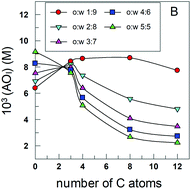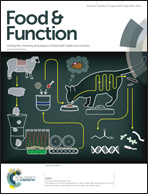Enhancement of the antioxidant efficiency of gallic acid derivatives in intact fish oil-in-water emulsions through optimization of their interfacial concentrations
Abstract
The antioxidant (AO) efficiencies and the distributions of gallic acid (GA) and a series of alkyl gallates (propyl, PG, butyl, BG, octyl, OG and lauryl, LG) were determined in intact fish oil-in-water emulsions. The efficiency of the AOs in inhibiting the oxidation of the fish oil lipids increases upon increasing AO hydrophobicity up to a maximum (∼3-fold) at the octyl derivative, after which the efficiency decreases (LG). The observed non-linear variation in the efficiency with the AO alkyl chain length parallels those of the percentages of AOs in the interfacial region and of their interfacial concentrations, but does not parallel that of the percentage of AOs in the oil region. The interfacial AO concentrations are 20–100 times greater than the stoichiometric (added) antioxidant concentration, depending on the interfacial surfactant volume fraction ΦI, meanwhile the AO concentrations in the oil are similar or slightly higher (1–6 fold) and the concentrations in the aqueous region are much smaller (0.8–10 fold). The effects of the oil to water (o : w) ratio on the interfacial concentrations are complex and depend on both the hydrophobicity of the AO and ΦI. An increase in the o : w ratio favors incorporation of hydrophilic AOs to the interfacial region of emulsions but it decreases the incorporation of hydrophobic AOs. Results provide, for the first time, experimental evidence supporting the interfacial region of emulsions as the main site of production of lipid radicals. Results also provide physical evidence that the efficiency of AOs depends on their interfacial concentrations, which can be modulated by increasing the hydrophobicity of the AOs and by employing the minimum amount of surfactant necessary to stabilize the emulsions. Changes in the o : w ratio can also be used to modulate the interfacial concentrations of hydrophobic (OG, LG, and to a lesser extent BG) or hydrophilic (GA) AOs, but not those of AOs of intermediate hydrophobicity (PG).



 Please wait while we load your content...
Please wait while we load your content...